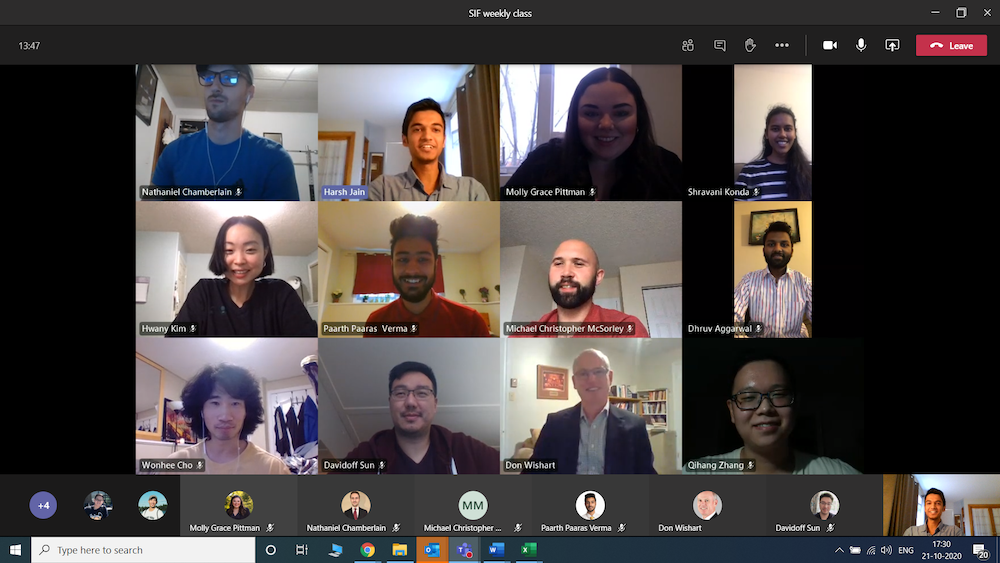SIF 2020: teaching and learning in the through the pandemic
Author: Faculty of Management
Posted on Oct 26, 2020
Category: Alumni , Student Investment Fund

Since COVID-19 hit last March, UNB’s Student Investment Fund (SIF) class has become a virtual undertaking. The University closed the campus and suspended all classes on March 13, but thanks to technology, UNB’s Centre for Enhanced Teaching and Learning and IT Services, faculties were able to swiftly move course materials onto the D2L platform and resume classes through MS Teams. All classes have been delivered via alternative methods using this technology and will continue to run in this manner at least for the current academic year. During the spring and summer, CETL offered intense training sessions for all faculty and staff to prepare everyone for teaching during the disruption.
The Centre for Financial Studies spent considerable time getting access to Bloomberg for students studying at home. Bloomberg ultimately introduced an internet-based access method, so that hurdle was overcome. Overall the alternate delivery method is certainly not a favourable permanent substitute for working in the classical SIF boardroom setting, but it is working.
While the classroom looks different, the SIF continues to deliver students hands-on investment learning as they manage the fund in partnership with Vestcor, SEAMARK and investment professors who prepare them for the CFA Level One exam. Additionally, the Centre for Financial Studies is coordinating experiential exercises that will allow students to test their skills.
Once again, the course is being team-taught by Don Wishart, Director for the Centre for Financial Studies, and Dean Culligan, VP Finance and Revenue, SimpTek Technologies. The modules they have prepared for students include the following:
- Company analysis. The course makes an effort to understand and evaluate a company’s strategic intent. As an example, the students recently used traditional methods such as Porter’s Competitive Strategy to evaluate Disney.
- Management Analysis. Have you ever read The Outsiders by William Thorndike? It describes the characteristics of eight CEO’s who outperformed the S&P500 by a factor of twenty. This reading is assigned to students to teach them that the right people can make a big difference.
- Financial Analysis. This is tough to grind through, but students learn how to do this by focusing on how the outcome of the effort should be a discernment of the expected growth rate of “free cash flow” in the future, which is a critical input to a valuation. The Dupont analysis of return on equity is a key component.
- Financial Ratio Analysis. Students focus on the ratios which most directly relate to the analysis above.
- Financial Model. Students extract existing corporate financials from Bloomberg and layer in a five-year forecast of their own.
- Valuation models. After reviewing several valuation approaches, the students use the most appropriate one(s) to finish their models.
- Ethics. Given the heavy weight of the CFA Level One exam on this topic the course includes a lecture on ethics in the CFA profession
- Presentations. Students present their initiation report on a company complete with a valuation model.
In addition, during each class, students are expected to provide updates on the sectors and companies they follow. The idea is to simulate a “morning scrum” in an investment management firm. Everyone relies very heavily on Bloomberg as the primary source for scrum items and the financial material mentioned previously.
In the coming months, student teams will be participating in virtual competitions, including the CFA Research Challenge, CFA Ethics or Ben Graham Value Investing competitions, as well as the Chicago Quantitative Alliance (CQA) Challenge, which is an equity portfolio management competition. They have also been invited to participate in the TMX options trading challenge which gives them hands-on-experience learning and implementing different options strategies in a simulated environment. After choosing which competition they would like to enter, they are being mentored by faculty members and industry partners.
This year, to create awareness of the SIF among junior business students, SIF students now serve on the executive committee of the Finance Club. This group is organizing a lunchtime speaker series featuring investment professionals who talk about the different careers in the industry and offer advice.
“One benefit of operating in a virtual world, is that time and geography are no longer barriers to who we can invite into the classroom. Our speakers can be located anywhere,” said Harsh Jain, Program Officer with the Centre for Financial Studies.
“COVID-19 is providing a difficult but unique learning environment for this group of SIF students that no generation before them has ever experienced. I am impressed by their resilience; it’s going to be very interesting to see where their knowledge and skills take them,” said Wishart.
If you are working in the investment industry and would like to get involved with our Student Investment Fund class as a guest speaker, please contact our Program Officer, Harsh Jain.
Photo: Members of the Student Investment Fund meet on MS Teams.
